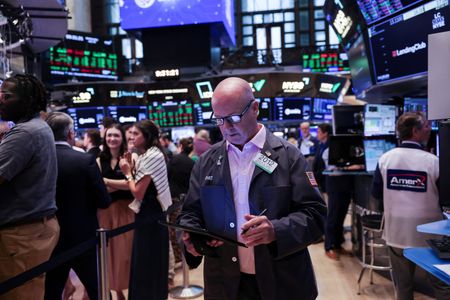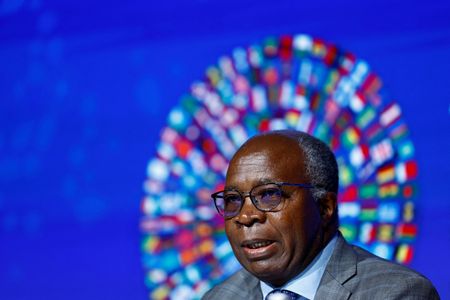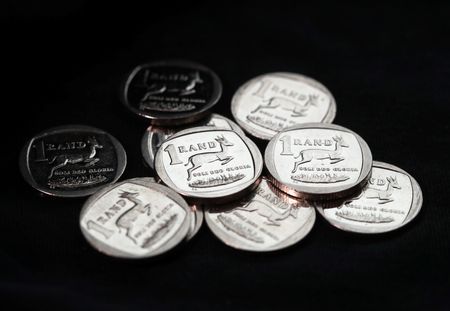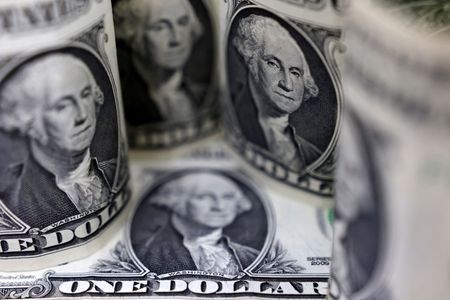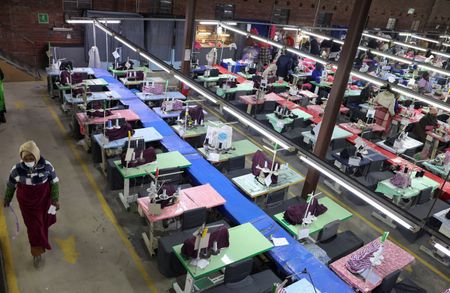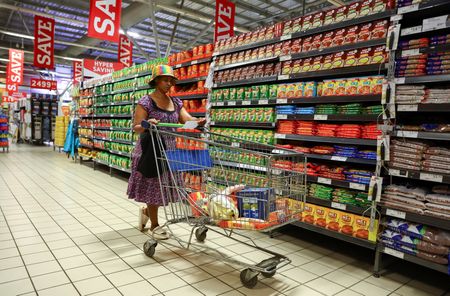By Chris Prentice and Amanda Cooper
NEW YORK/LONDON (Reuters) -Wall Street stock indexes were lower on Tuesday following weaker than expected U.S. economic data, as equities in Europe and Asia gained ground.
U.S. services sector activity unexpectedly flatlined in July with little change in orders and a further weakening in employment even as input costs climbed by the most in nearly three years, highlighting the uncertainty over the impact of Trump’s tariff policy on businesses.
The Dow Jones Industrial Average fell 40.08 points, or 0.09%, to 44,133.14, the S&P 500 fell 0.71 points, or 0.01%, to 6,329.23 and the Nasdaq Composite rose 39.72 points, or 0.19%, to 21,093.99.
The U.S. dollar steadied as investors raised bets the Federal Reserve would act to prop up the world’s largest economy.
Gold prices fell from two-week highs, and oil retreated on rising OPEC+ supply and worries of weaker global demand.
On Monday, U.S. shares had rallied on generally positive earnings reports and increasing bets for a September rate cut from the Fed after disappointing jobs data on Friday.
The pan-European STOXX 600 index rose 0.35%, echoing the strength across Asia markets, where MSCI’s broadest index of Asia-Pacific shares outside Japan closed up 0.77%.
European earnings season was in full swing, with Diageo jumping 4.55%.
“The removal of the uncertainty is one factor that is helping European markets, even if the tariff rate is probably a bit higher than what market participants or European politicians would have expected or hoped to see,” said Amelie Derambure, senior multi-asset portfolio manager at Amundi.
“The question is whether bad news is bad news (economy slowing down) or it’s good news (Fed moving towards rate cuts). Our view is that it depends on how bad is the data and what’s priced in,” Jefferies strategist Mohit Kumar said.
“A modest weakening of the economy would be good news as it should be more easing from the Fed. However, a sustained and sharp rise in unemployment rates would be a negative as it would raise concerns over growth and earnings,” he said.
The dollar index, which measures the U.S. dollar against a basket of currencies, including the yen and the euro,rose 0.36% to 98.99. The euro was 0.29% at $1.1536.
Odds for a September rate cut now stand at about 94%, according to CME Fedwatch, from a 63% chance seen on July 28. Market participants see at least two quarter-point cuts by the end of this year.
News that Trump could fill a governorship position at the Fed early added to worries about politicization of interest rate policy.
Trump again threatened to raise tariffs on goods from India from the 25% level announced last month due to its Russian oil purchases, while New Delhi called his attack “unjustified” and vowed to protect its economic interests.
“Whether the threat of secondary sanctions on India’s financing of Russia is the core goal remains to be seen,” strategists at ING said. “Or indeed, this move may be increased U.S. leverage on India to open up its domestic economy to agricultural imports or commitments to buy U.S. energy instead.”
Oil prices dropped for a fourth day, with concern mounting about economic growth and the potential for oversupply. Brent crude futures were down 1.21% at $67.93 per barrel and U.S. crude down 1.33% to $65.41.
The second-quarter U.S. earnings season is winding down, but investors are still awaiting results this week from companies including Walt Disney and Caterpillar.
Data on Tuesday showed business activity in the euro zone grew at a slightly faster pace in July than in June, but remained sluggish.
A separate UK survey showed British businesses recorded their largest drop in new orders in almost three years in July and cutting staff by the most in six months.
Data from Asia’s two biggest economies showed resilience in their service sectors. In Japan, the S&P Global final services purchasing managers’ index (PMI) climbed to 53.6 in July from 51.7 in June for the strongest expansion since February. China’s services activity last month expanded at its fastest pace in more than a year.
Spot gold prices were last down 0.04% to $3,371.59 an ounce, and spot palladium fell as much as 3% to $1,169.50 before paring losses.
(Additional reporting by Rocky Swift in Tokyo, Twesha Dikshit and Medha Singh; Editing by Lincoln Feast, Bernadette Baum, Giles Elgood and Jane Merriman)

